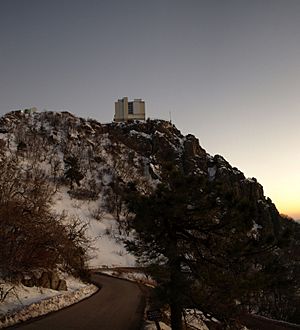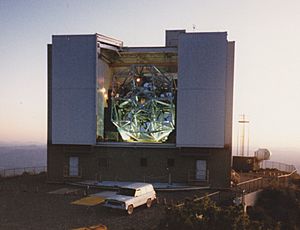MMT Observatory facts for kids

MMT Observatory
|
|
| Alternative names | MMTO |
|---|---|
| Part of | Fred Lawrence Whipple Observatory Steward Observatory |
| Location(s) | Arizona |
| Coordinates | 31°41′18″N 110°53′06″W / 31.6883°N 110.885°W |
| Organization | University of Arizona |
| Altitude | 2,616 m (8,583 ft) |
| Telescope style | optical telescope |
| Diameter | 6.5 m (21 ft 4 in) |
| Mounting | altazimuth mount |
| Website | www |
The MMT Observatory (MMTO) is a special place where scientists study space. It is an astronomical observatory located on Mount Hopkins in Arizona, USA. This mountain is about 55 kilometers (34 miles) south of Tucson.
The observatory is part of the Fred Lawrence Whipple Observatory complex. It is run by the University of Arizona and the Smithsonian Institution. There is also a visitor center nearby in Amado, Arizona, where you can learn more.
The main part of the MMTO is the MMT telescope. It has a huge primary mirror that is 6.5 meters (21 feet) wide. The name MMT used to stand for "Multiple Mirror Telescope." This is because it originally used six smaller mirrors. These were replaced with one large mirror in 1998.
The large mirror has a special lightweight design. It looks like a honeycomb inside. This design was created by the University of Arizona's Steward Observatory Mirror Laboratory. The MMT telescope is inside a building that can open up completely. Its walls and roof can roll back. This helps the telescope cool down quickly. Cooling helps it get clearer views of space.
Contents
How the MMT Telescope Changed
The MMT telescope has changed a lot over the years. It started with many mirrors and now uses one giant mirror. This made it even better for looking at distant stars and galaxies.
The First MMT: Multiple Mirrors (1979–1998)
From 1979 to 1998, the MMT was called the Multiple Mirror Telescope. It used six smaller mirrors. Each of these mirrors was about 1.8 meters (72 inches) across. These mirrors were given to the observatory after a secret project was canceled.
Together, these six mirrors collected as much light as one large 4.5-meter (15-foot) telescope. This made it the third-largest optical telescope in the world at that time. The telescope had a very new design. It had an unusual way of collecting light. Also, its building could turn with the telescope. It used a special mount that moved up-down and left-right.
Most large telescopes before the MMT used a different type of mount called an equatorial mount. The MMT helped change how telescopes were built. Now, almost all big optical telescopes use the same up-down and left-right mount. The MMT also helped develop many new technologies. These included:
- Very accurate motors for moving the telescope.
- Precise pointing that meant scientists didn't need old star charts.
- Ways to make multiple telescopes work together.
- Making the telescope's environment cooler for better viewing.
- New ways to clean and maintain the mirrors.
- Early tests with adaptive optics, which correct blurry images.
The New MMT: Single Mirror (1998–Present)
It used to be very hard to make one giant mirror for a telescope. But a scientist named Roger Angel at the University of Arizona found a solution. He learned how to make huge mirrors with a honeycomb shape inside. He did this by spinning hot glass in a special oven.
This new method made it possible to replace the six smaller mirrors with one giant 6.5-meter (21-foot) mirror. The observatory was able to reuse its original building and some of its structure. This new mirror was the first of its size to be made and polished at the Steward Observatory Mirror Laboratory. The updated MMT, which no longer stands for "Multiple Mirror Telescope," was officially reopened on May 20, 2000.
In 2002, a special secondary mirror was added to the telescope. This mirror can change its shape very quickly. It helps correct distortions in the light from space. This technology is called adaptive optics. It makes images much clearer, especially when looking at infrared light. The MMT's adaptive optics system helped design the Large Binocular Telescope. That telescope achieved amazing clarity in its images in 2010.
From 2004 to 2010, some of the MMT's observing time was shared. This allowed other astronomers to use the telescope. This program was supported by the US National Science Foundation.
See also
 In Spanish: Observatorio MMT para niños
In Spanish: Observatorio MMT para niños
- Massive Monolithic Telescope A telescope made from a single piece of glass
- List of astronomical observatories
- List of largest optical reflecting telescopes
- List largest optical telescopes in the continental United States



